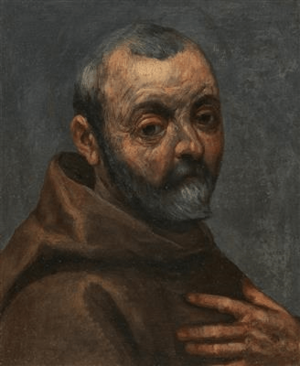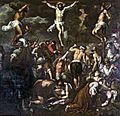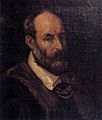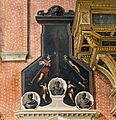Palma il Giovane facts for kids
Quick facts for kids
Palma Giovane
|
|
|---|---|

Supposed self-portrait as a monk
|
|
| Born | 1548/50 |
| Died | 14 October 1628 (aged 77–80) |
| Nationality | Italian |
| Known for | Painting |
| Movement | High Renaissance |
Iacopo Negretti (born between 1548 and 1550 – died October 14, 1628) was a famous Italian painter. He is better known as Jacopo Palma il Giovane or simply Palma Giovane, which means "Young Palma". He came from Venice, a city in Italy, and was an important artist of the Venetian school of painting.
After another famous painter named Tintoretto passed away in 1594, Palma Giovane became the most important artist in Venice. He continued to paint in a similar style to Tintoretto. He also received many requests for paintings from places outside Venice, especially in the area of Bergamo. He even painted for important people in Central Europe, like Emperor Rudolph II in Prague.
Contents
Biography
Early Life and Training
Palma Giovane was born in Venice into a family of painters. His great-uncle was the well-known painter Palma Vecchio ("Old Palma"). His father, Antonio Nigreti, was also a painter. Antonio learned from Palma Vecchio's workshop manager, Bonifacio de' Pitati. When Bonifacio died, Antonio took over his workshop. Young Palma learned a lot by copying paintings by the famous artist Titian.
In 1567, Guidobaldo II della Rovere, who was the duke of Urbino, saw Palma's talent. He supported Palma for four years and sent him to Rome. Palma stayed in Rome until about 1572.
Return to Venice and Famous Works
When Palma returned to Venice, he started to follow the style of Tintoretto. Some early writers about Palma say that he worked in the workshop of the aging Titian. When Titian died, Palma helped finish his last painting, called Pietà. This painting is now in the Accademia museum in Venice.
Palma's first big public job came after a fire in the Doge's Palace in 1577. He painted three scenes for the palace's grand council hall. By the mid-1580s, he had learned how to use Tintoretto's different body poses and Titian's thick paint, focus on light, and loose brushstrokes.
Palma Giovane worked with other famous painters like Paolo Veronese and Tintoretto on the decorations in the Doge's Palace. This helped him fully understand the Venetian painting style. From 1580 to 1590, he painted many large pictures for Venetian schools and churches. These included paintings for the sacristies of San Giacomo dall'Orio and the Jesuit church (Gesuiti), the Scuola di San Giovanni Evangelista, and the Oratorio dei Crociferi. These works are considered some of his best.
Later Career and Legacy
Palma il Giovane later set up his own large art studio. From this studio, he created many religious and allegorical paintings. These artworks can be found all over the area that was once the Venetian Republic. One of his famous works is Venus with a Mirror, which was inspired by Titian. After 1600, he also painted mythological scenes for a small group of thinkers.
After Tintoretto's death in 1594, Palma remained one of the most important painters in Venice. He was asked to finish Titian’s Pietà, which was not complete. Palma proudly wrote on the painting: ‘QUOD TITIANVS INCHOATVM RELIQUIT PALMA REVERENTVR ABSOLVIT DEOQ. DICAVIT OPVS’. This means: "What Titian left unfinished, Palma reverently completed and dedicated the work to God."
Palma Giovane was buried in the Basilica di San Giovanni e Paolo. This church was a traditional burial place for important leaders of Venice. One of his students was a painter named Camillo Rama.
Gallery
-
Pope St. Pius V
Images for kids
See also
 In Spanish: Palma el Joven para niños
In Spanish: Palma el Joven para niños









